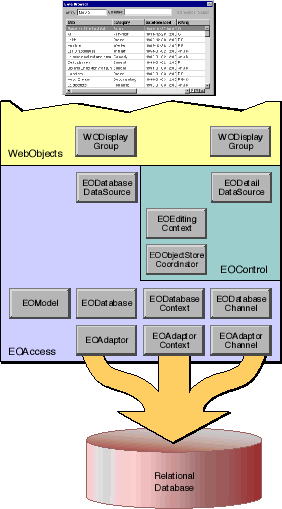 Table of Contents
Table of Contents  Previous Section
Previous Section
Classes in an HTML WebObjects Application
The major difference between an Application Kit application and an HTML web application is that the web application uses the WebObjects framework instead of the Application Kit. Figure 17 shows how the WebObjects framework provides a web application's presentation layer.The WebObjects box is jagged at the top because not all of the WebObjects classes that participate in user interface management are illustrated. For example, the WebObjects framework provides user interface elements such as WOTextField and WOBrowser for generating web pages that users see in their browsers. None of these classes are shown. Rather, Figure 17 shows only the WebObjects framework class that acts as the go-between for Enterprise Objects Framework's control layer and WebObjects user interface: WODisplayGroup.
WODisplayGroup is analogous to the interface layer's EODisplayGroup. They have virtually the same APIs, but EODisplayGroup works with the interface layer's EOAssociation's and WODisplayGroup works with WebObjects framework elements.
Figure 17. Classes in an HTML WebObjects Application

 Table of Contents
Table of Contents  Next Section
Next Section